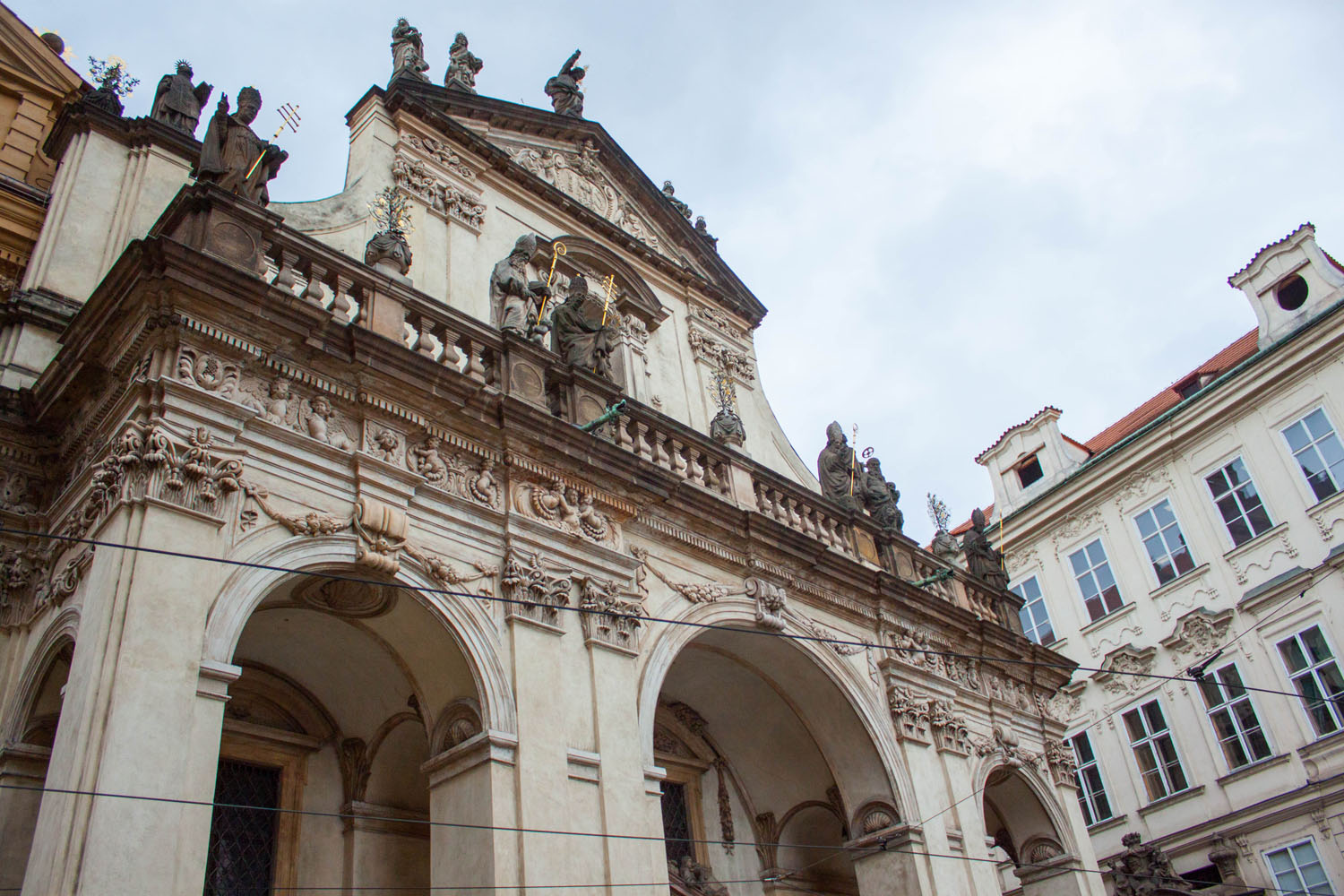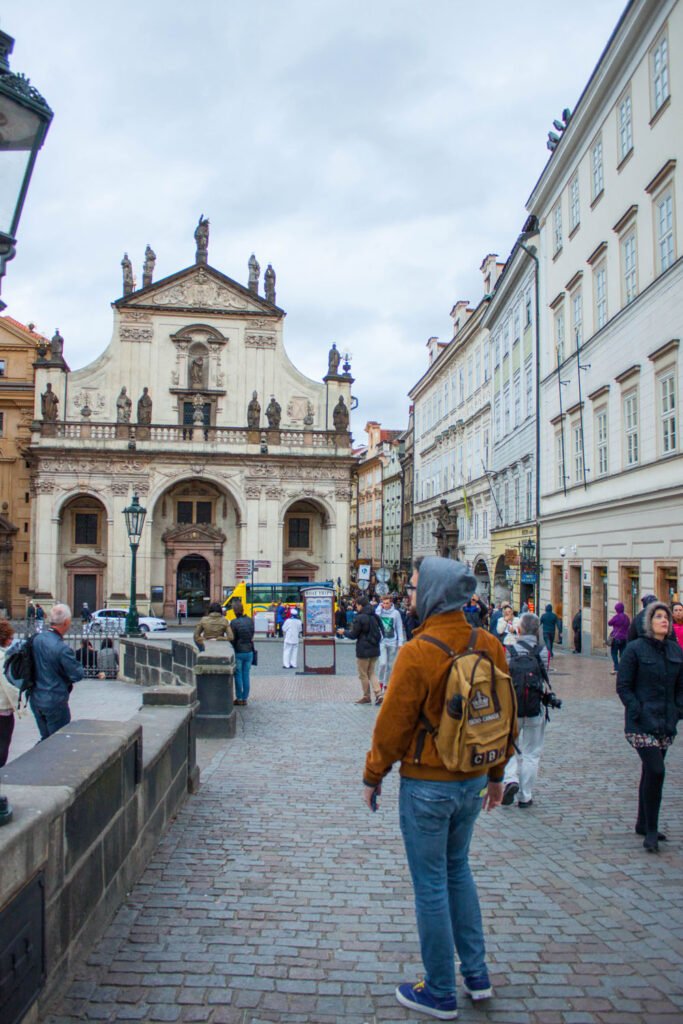

Today, we’re excited to take you on a journey to one of Prague’s most iconic and historic landmarks: The Klementinum. Prague has some of the most beautiful libraries in the world. Although most of them are off-limits to the public, there are tours during certain times of the day, allowing bibliophiles to soak up all the history and literary treasures that lie inside these old buildings.
The Klementinum is a large building complex that stretches across an entire city block. Since the 15th century, astronomers, scientists, philosophers and musicians have poured through its door to study the precious books inside. These great men of science and art came together here. Each influenced the other and developed some of the modern era’s most incredible inventions. The Klementinum is home to several important institutions, including the National Library of the Czech Republic. But it is also an architectural and cultural treasure. With its stunning Baroque facade, beautiful courtyards, and intricate decoration, the Klementinum is a true feast for the eyes. So, join us as we discover the hidden gems and hidden stories of this beautiful complex.


The only way to get into the libraries is by a guided tour (unless you’re a Czech scholar). These run about every hour and are worth every penny! For tour times and hours, visit their website.
To find the entrance to the tour, you walk through a small set of wooden doors near the church. Inside you will see a ticket booth with a cramped employee sitting behind the glass. After purchasing your ticket, you wait for your tour guide. Once they arrive, you’ll be whisked off throughout this gorgeous building.
Tickets cost: 300 Kc for Adults ($13 USD), 200 Kc ($9 USD) for Students and Seniors and children are free.
The Klementinum dates all the way back to the 11th century. It was formerly a tiny chapel dedicated to Saint Clement run by Dominican monks. The Hapsburg Emperor Ferdinand I wanted to help increase his power within the Roman Catholic Church and in Bohemia (now Prague). To do this, he invited the Jesuits into his city.
Wanting to make them feel more at home and give them some sense of importance, the Emperor gifted them the building now known as the Klementinum. It had a prime location, right across from the Charles Bridge, and was an excellent gift for the order.
In 1556, the library’s development began. By 1653 they had managed to build one of the most significant collections of books and the literary material in Europe. When the entire library was finished, it was the most massive building in Prague, after Prague Castle. Eventually, the Jesuits fell out with the Pope. So in 1773, the library was given over to Prague’s people and became a part of Charles University.
The first room that the guide will take you into is the Great Mirror Chapel. The architecture of the Klementinum varies from room to room, as different parts of the building were built during different periods. This room, however, is an excellent example of Baroque architecture. The Mirror Chapel was built in 1724 and features ornate frescoes, mirrors, the ceiling, and intricate gilded stucco. The rust-coloured walls and peach-painted ceiling are a unique touch. They make the chamber glow and make the visitor feel warm and cozy.
Today, we’re excited to take you on a journey to one of Prague’s most iconic and historic landmarks: The Klementinum. Prague has some of the most beautiful libraries in the world. Although most of them are off-limits to the public, there are tours during certain times of the day, allowing bibliophiles to soak up all the history and literary treasures that lie inside these old buildings. The Klementinum is a large building complex that stretches across an entire city block. Since the 15th century, astronomers, scientists, philosophers and musicians have poured through its door to study the precious books inside. These great men of science and art came together here. Each influenced the other and developed some of the modern era’s most incredible inventions. The Klementinum is home to several important institutions, including the National Library of the Czech Republic. But it is also an architectural and cultural treasure. With its stunning Baroque facade, beautiful courtyards, and intricate decoration, the Klementinum is a true feast for the eyes. So, join us as we discover the hidden gems and hidden stories of this beautiful complex.The faux marble columns along the walls each contain a beautifully framed work of art. These works of art were primarily created by Jan Hiebl, a Czech artist of little note. But Hiebl made a significant impression on the people who visit this chapel. One of the most important things to look at here is the two organs. The first was played by Wolfgang Amadeus Mozart on his visits to the Klementinum.
This chapel can also be visited if you buy tickets to one of their “Classical Concerts.” These concerts are a fantastic option for visiting the Klementinum outside a guided tour. You will be treated to music from the 18th century played on the historic organ during the show. Usually performed by gifted local musicians. The very same organ played by Mozart himself now hosts new talented musicians hoping to become the following great composer!
After soaking in all the beauty inside the chapel, your guide leads up the first set of narrow stairs to the 2nd floor. This is where the historic library is housed. On the way to the library, you pass by various glass cabinets of curiosity. These different house instruments are used by astronomers to explore the skies, track weather and map constellations.
The corridor is covered in ornate stucco, and the ceiling contains frescoes. Each scene is drawn from prominent literary writings, like echoes of the past, leading you down toward your destination.
Although you can’t walk inside the library and pick up any books, there are various special volumes under the glass. These examples give you a glimpse of the books you’d find on the shelves within. Each one is masterfully handpainted with perfect calligraphy and illustration on every page. Monks would spend a lifetime creating a few copies of the same book. They would disperse the copies to only a few prestigious libraries worldwide.
As the guide leads you to the only open set of doors, you will be immediately taken aback by the tremendous amount of things to look at inside the Great Library. The shelves housing over 20,000 books from the early 17th century onwards are a stunning display. There is a sea of baroque finishings washing over the walls.
The ceiling features a large fresco, an original part of 18th-century design. The paintings on the ceiling depict the Temple of Wisdom, a city from Greek Mythology, which was thought to have housed thousands of theological volumes dating back to 1600. Jan Hiebl, the same artist who painted the frescos in the Mirror Chapel, also did these frescos. He uses light and shadow to create a domed effect even on the flat ceiling. Hiebl spent tireless hours giving the illusion of natural sunlight pouring into space despite natural light being restricted to protect the books from damage.
The bookshelves are carved from stunning dark wood, which shines even in the dim light. Some columns are carved into spirals, topped off with gold capitals. Above the tops of each bookshelf are golden frames with the names of prominent Jesuits inscribed on them. These Jesuits were the people who helped build this impressive library.
The books in the collection consist mainly of theological volumes in various foreign languages. It also contains a Mozartiana, a book about the life of Tycho Brahe and Comenius. You’d also find historical examples of famous Czech literature. Some of the collections’ books are so rare and unique that they have been given to Google to be digitally preserved online for everyone to see.
In the centre of the room are various globes of different sizes, displaying historical diagrams and maps of the world. You can see how opinions have changed throughout the years on the map of the world. The shapes of continents would grow or shrink based on the newest technology or information. There are also several sets of celestial globes to be found here. Celestial spheres show the position of the stars in the sky.
Although you might not want to leave, eventually, the tour guide must move on. You are taken to the next floor, which contains Meridian Hall. The Meridian Hall was an invention designed to determine and mark twelve noon. When the scientists inside would see that noon had come (based on their instruments), they would ring the bells from the top of the bell tower. This would indicate to the rest of the town that it was midday. Alongside the Meridian Hall is several weather recording devices that note the temperature as early as 1775. These are even still used today to continue to record the weather.
You can mount the final, very narrow, rickety set of stairs to walk out onto the bell tower. You must climb up 172 steps to get to the top of the building. But you’ll be rewarded with a stunning 360° view of Prague’s red-topped roofs.
Being up here helps you understand where everything is in Prague. You can see all the important landmarks, and bronze diagrams help identify all the famous buildings you’re looking down at. This was so helpful since we’d see something far off in the distance and want to make a note of tracking it down once back on land.
Seeing as the tour group is so small, you have this view all to yourself once the group spreads out. It was so romantic and truly an oasis of serenity in a city which can be overwhelming and full of tourists.
A massive bronze sculpture of Atlas holds up the world on the very top of the bell tower. On our way out, we looked at the top of the tower from where we were once standing. The Klementinum and the Strahov Monastery are my two favourite landmarks in Prague. You MUST visit them if you’re ever in the city, especially if you’re a library lover like me!
Perched dramatically on a limestone hill overlooking the lush Tipperary countryside, the Rock of Cashel…
Affectionately known as the "Garden of Ireland," Wicklow County is one of the most breathtaking…
Paris has long been a magnet for writers for hundreds of years, with iconic figures…
Paris transforms into a magical wonderland from November to January, bursting with festive charm and…
French cuisine is one of the coziest delights to savour in winter. With its hearty…
During the festive season, Paris becomes a sparkling holiday dream, with twinkling fairy lights cascading…
This website uses cookies.